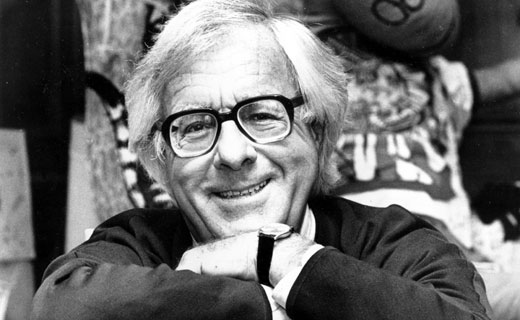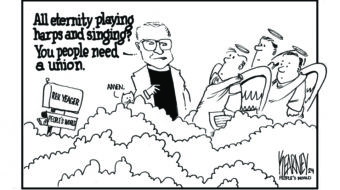
On June 5, the world lost a unique talent with the passing of Ray Bradbury. His imaginative fiction has endured for many decades, and readers of science fiction will agree that no other writer captured that certain brand of wonder that Bradbury seemed to have all to himself.
Bradbury’s career is usually noted for a handful of works: “The Martian Chronicles,” “Something Wicked This Way Comes,” “The Illustrated Man,” and, perhaps most famously, “Fahrenheit 451.” But Bradbury was a prolific writer whose work continued undiminished up to recent times.
Very little of Bradbury’s work was in the form of the conventional novel. He was very much a master of short fiction. His young life involved the very early science fiction fan culture that was born of the pulp magazines of the ’30s and ’40s. His first published work was in the early fanzines. In this milieu, he met a collection of other young fans who would also go on to their own fame, such as future stop-motion animator/filmmaker Ray Harryhausen and future magazine editor Forrest J. Ackerman. But Bradbury from early on had a palpably different approach to his work that grew to full character within a short amount of time.
While there are many notable science fiction authors from the past who pushed the genre past the marginal world of the cheap magazines into a realm of near respectability, few chose the path that Bradbury did. There is literary merit to the works of Isaac Asimov, Robert Heinlein, and Arthur C. Clarke, but much of their work seems chained to matters of envisioning a future with working pieces and parts, a sort of engineering of dreams.
Even works like Frank Herbert’s “Dune” seem often weighted by the rich detail with which far-flung worlds, empires, and religions are crafted. Bradbury alone seemed able to craft delicate language that created shadows and impressions that were felt a bit deeper within the reader’s imagination.
Reading some classic Bradbury now, we see a spirit that nimbly resists belonging to a given era. Much of what occurs in Bradbury’s stories are within that twilight where fear or wonder replaces a sense of normal reality. The diaphanous character of Bradbury’s words set his storytelling free from the gravity of ordinary detail, and often the most solid reference points with these tales are emotional. Take for instance “Something Wicked This Way Comes,” with its masterly weaving of innocent small-town childhood and shadowy, otherworldly menace.
For a writer often contemplating the future, Bradbury was a bit parochial and charmingly so. He often connected the unfamiliar or startling to a sort of small-town Americana long gone. A sense of gentle humanity runs uninterrupted through all his work, from the early stories of rocketships and dinosaurs to the charming mysteries of later years.
Occasionally, Bradbury would connect imagination with alarm, as in his most famous novel of firemen who burn books – “Fahrenheit 451.” The writer claimed it was his only true work of science fiction, in that he crafted a situation he could see actually happening, and he claimed that it was written as a preventative measure, at the height of the 1950s Red Scare.
Woven into the many treasured short story analogies are moving and realistic portraits of people dealing with the horrors of the world as it is, such as 1947’s “I See You Never” (which appeared in The Golden Apples of the Sun), a brief but heart-wrenching contemporary story of an immigrant being deported.
Politically, Bradbury was most outspoken during the Red Scare and the Vietnam War. He was alarmed enough by the witch-hunts to take out a full-page ad in Variety denouncing the Republican Party at the height of McCarthyism. He was loudly critical of LBJ for escalating the conflict in Vietnam.
In recent years, he seemed far less engaged, though attempts by the right to claim Bradbury as another conservative voice in science fiction seem hollow and disingenuous. Much is made of Bradbury’s issues with filmmaker Michael Moore appropriating the title of Bradbury’s most famous work for Moore’s film Fahrenheit 9/11, but that conflict had nothing to do with the content of the film. In casting Bradbury as a conservative mind (especially considering what that entails these days) the right-wing National Review obviously exercised more imagination than Bradbury ever hoped to.
Speculative fiction is no longer what it was during the days when Bradbury was producing his most noted work. It’s a reliably commercial genre nowadays, which seldom tackles issues as it did when it was more peripheral. Many have noted the genre seeming to move to the right, with fewer polemic or utopian visions. Perhaps the future just isn’t quite what it used to be.
Bradbury was a master of the written word, and though his work was often filmed, it rarely survived with much of its worth apparent in the final product. Adapting what Bradbury conjured to something as pedestrian as the average Hollywood film was never going to be a promising scenario. Few of the films are remembered, and rightly so.
“Fahrenheit 451” was adapted into a film by Francois Truffaut for his first English-language production. Though Truffaut judged it a failure on his part and felt he hadn’t done the book justice, the 1966 film does have much merit, with a wan absurdity that holds one’s attention. It’s very different in tone from the book, but positions the premise within a pop art world of detachment and alienation, with the forbidden books offering an escape into a remote world of warm, human dimension brought forward in a lyrical conclusion.
Bradbury’s legacy was present in film through the inspiration others took from his approach. Both Twilight Zone’s Rod Serling and Steven Spielberg were admitted fans who came close in their best work to the strange and wonderful realm Bradbury staked out on his pages.
Though popular and noteworthy, Bradbury still seems confined in America to genre fiction. Perhaps his death will serve to elevate him. If ever there were a talent worthy of high regard, this gentle cauldron of imagination seems a figure that ought to be regarded as a national treasure.
Photo: Lennox McLendon/AP












Comments